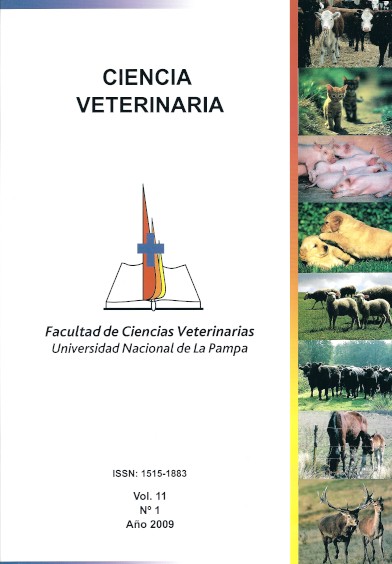Anti estrogens effect of citrate of tamoxifen on testicular and seminal parameters of male dogs
Keywords:
Tamoxifen, Anti estrogen, Reproduction, DogAbstract
The citrate of tamoxifen is a synthetic non steroid type I anti-estrogenic compound, which block competitively estrogens receptors with agonist and antagonist combine action. The mechanism of action varies in relation to species, organs, tissue and cells. The objective of the present study was to describe the macroscopic testicular and seminal epididymis changes in domestic dogs treated with citrate of tamoxifen. Six clinically, 2 - 5 years old healthy dogs between 15 - 25 kg of weigh were analysed. The study included a pretreatment, treatment and post-treatment period of 15, 30 and 45 days, respectively. During the treatment period the animals received 5 mg/day of tamoxifen, and every 15 days clinical examination of testicular consistency and size, libido and epididymal semen were evaluated. ANOVA was used to evaluate quantitative data while the categorical data were evaluated by Chi2. The libido of the animals decreased from the day 15 of the study until the day 75 where start to increase again. The testicular consistency and size decreased from 30 to 60 days, recovering pre-treatment size by day 75 of the study, and at the same time not evidence of epididymis semen were recorded. The percentage of live spermatozoa and motility decreased significantly between treatment days 0 to 30. These clinical testicular and epididymal seminal parameters showed an application of citrate of tamoxifen in male dogs as an effective, sudden and sure method of reversible contraception.Downloads
Downloads
Published
How to Cite
Issue
Section
License
Al momento de enviar sus contribuciones, los colaboradores deberán declarar , de manera fehaciente, que poseen el permiso del archivo o repositorio donde se obtuvieron los documentos que se anexan al trabajo, cualquiera sea su formato (manuscritos inéditos, imágenes, archivos audiovisuales, etc.), permiso que los autoriza a publicarlos y reproducirlos, liberando a la revista y sus editores de toda responsabilidad o reclamo de terceros , los autores deben adherir a la licencia Creative Commons denominada “Atribución - No Comercial CC BY-NC-SA”, mediante la cual el autor permite copiar, reproducir, distribuir, comunicar públicamente la obra y generar obras derivadas, siempre y cuando se cite y reconozca al autor original. No se permite, sin embargo, utilizar la obra con fines comerciales.



4.png)


7.png)



